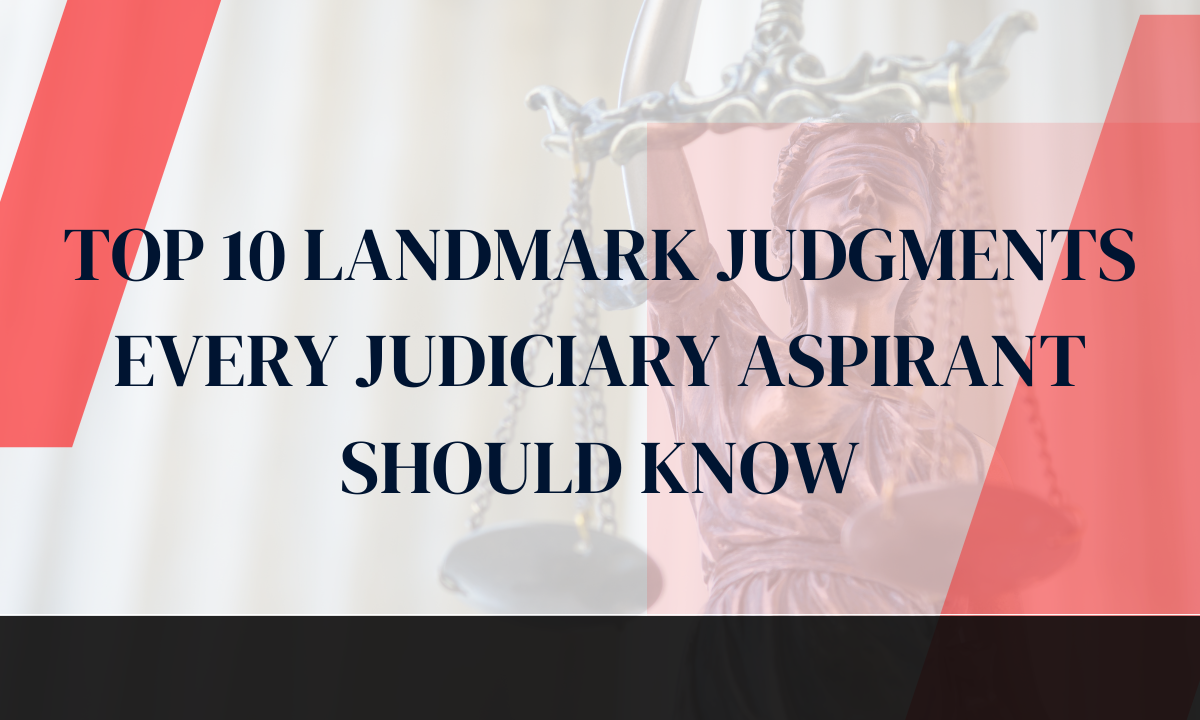+91 9990898327
Office : 632, Dr. Mukherjee Nagar, Delhi 110009
Mon-Sun: 09:00AM - 08:00PM


Landmark decisions are the primary movers of the Indian judicial system. They create priceless precedents, construe constitutional ideas, and develop justice. Those looking for a judiciary should be properly endowed with these landmark decisions so they are able to grasp their meaning in the context of the history of law and jurisprudence of the contemporary era. Emboldened below are the top ten most effective decisions which have held significant meanings in India's legal system.
Swami Kesavananda Bharati objected to the Kerala government's action in acquiring his religious institution's property through the Land Reforms Act. The case resulted in one of the most significant judicial utterances in Indian constitutional history.
Basic Structure Doctrine was put forth by the Supreme Court by pronouncing that Parliament can change the Constitution but not anything in its basic structure. The features such as democracy, secularism, and the autonomy of the judiciary cannot be amended.
This verdict held in check the emergence of authoritarian rule by formulating that there are some values of the Constitution which can't be modified even by Parliament.
Maneka Gandhi’s passport was impounded without explanation, leading her to challenge the decision as a violation of her fundamental rights.
The Supreme Court held that Article 21 (Right to Life and Personal Liberty) should not be interpreted narrowly. The court ruled that any law affecting personal liberty must be just, fair, and reasonable.
This decision enlarged the scope of Article 21 and made it the precedent for the majority of the subsequent cases of personal liberty and due process in India.
The case was regarding the central government dismissing some state governments under Article 356 (President's Rule).
The Supreme Court ruled that President's Rule cannot be invoked to force the dissolution of state governments arbitrarily. Courts would examine the legality of such removals.
This ruling strengthened federalism in India by not allowing the central government to remove democratically elected state governments arbitrarily.
This case was founded on the horrific gang rape of a social worker, and it was utilized to highlight the lack of legal protection against sexual harassment in the workplace.
The Supreme Court created the Vishaka Guidelines, which were the template for workplace sexual harassment law in India.
These norms led to the enforcement of the Sexual Harassment of Women at Workplace (Prevention, Prohibition and Redressal) Act, 2013, which offers protection to women through law at the workplace.
The pavement dwellers of Mumbai organized a protest against being driven away by the municipal corporation on the premise that it went against their right to livelihood.
The Supreme Court held that the Right to Livelihood is included in the Right to Life under Article 21.
This judgment re-asserted the socio-economic aspect of fundamental rights and has been used subsequently in urban displacement as well as poverty reduction.
The case challenged the possibility of reservations to Other Backward Classes (OBCs) in government positions.
The Supreme Court confirmed the 27% reservation of OBCs but incorporated the theory of the "Creamy Layer". Wealthier OBC members will not come under the shelter of reservation benefits.
This judgment sustained the need for social justice but made sure that only the genuinely deprived sections of society benefit from positive action.
Shah Bano, a Muslim woman, had sought maintenance from her husband when she was divorced through triple talaq.
The Supreme Court held that Section 125 of the Criminal Procedure Code (CrPC) applies to all citizens, including Muslim women, to protect their right to maintenance.
This judgment led to a nationwide debate about the Uniform Civil Code (UCC) and the Muslim Women (Protection of Rights on Divorce) Act, 1986 was enacted limiting the impact of the ruling.
Keshav Singh was incarcerated by the Uttar Pradesh Legislative Assembly for contempt, leading to a constitutional crisis.
The Supreme Court declared that legislative immunities cannot hinder fundamental rights and are subject to judicial review.
The ruling set the limits of legislative immunity and upheld the role of the judiciary in safeguarding citizens rights.
The Golaknath family protested against land reform laws under the grounds that their fundamental rights were being exploited.
The Supreme Court decided that Parliament cannot make any changes to Fundamental Rights and they cannot be modified.
This decision was later overruled by the Kesavananda Bharati case (1973), which held the Basic Structure Doctrine. However, it played a crucial role in determining constitutional interpretation.
A set of petitioners challenged Section 377 of the Indian Penal Code, criminalizing homosexuality.
The Supreme Court legalized consensual same-sex relationships, holding that Section 377 was unconstitutional on the grounds that it curbed fundamental rights such as the right to privacy, equality, and dignity.
This judgment was a major milestone in achieving LGBTQ+ rights in India, paving the way for greater social acceptance and legal protection.
These landmark judgments transformed the Indian judiciary and continue to be guiding principles in the backdrop of court judgments even today. Candidates who apply for entry into the judiciary must study these cases in detail because these cases outline the shifting patterns of constitutional interpretation, fundamental rights, and judicial activism. Every judgment illustrates the tug of war among state powers and citizens rights and enforces the concepts of justice, democracy, and equality. It is necessary for anyone studying judicial services exams or hoping to serve India's legal system meaningfully to understand these judgments.
Post a comment